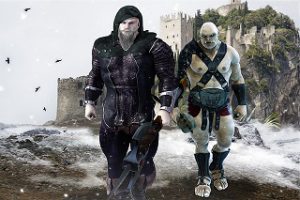This is mark Joseph “young” blog entry #359, on the subject of Characters Engage.
With permission of Valdron Inc I have previously completed publishing my first six novels, Verse Three, Chapter One: The First Multiverser Novel, Old Verses New, For Better or Verse, Spy Verses, Garden of Versers, and Versers Versus Versers, in serialized form on the web (those links will take you to the table of contents for each book). Along with each book there was also a series of web log posts looking at the writing process, the decisions and choices that delivered the final product; those posts are indexed with the chapters in the tables of contents pages. Now as I am posting the seventh, Re Verse All, I am again offering a set of “behind the writings” insights. This “behind the writings” look may contain spoilers because it sometimes talks about my expectations for the futures of the characters and stories–although it sometimes raises ideas that were never pursued, as being written partially concurrently with the story it sometimes discusses where I thought it was headed. You might want to read the referenced chapters before reading this look at them. Links below (the section headings) will take you to the specific individual chapters being discussed, and there are (or will soon be) links on those pages to bring you back hopefully to the same point here.
There is also a section of the site, Multiverser Novel Support Pages, in which I have begun to place materials related to the novels beginning with character papers for the major characters, giving them at different stages as they move through the books.
This is the fourth mark Joseph “young” web log post covering this book, covering chapters 19 through 24. It was suggested that more shorter posts were a better choice than fewer longer ones, so there will be posts every six chapters, that is, every other week, for this book. Previous entries were:
- #354: Versers Reorienting, covering chapters 1 through 6;
- #355: Versers Resettling, for chapters 7 through 12.
- #357: Characters Connect, for chapters 13 through 18.

History of the series, including the reason it started, the origins of character names and details, and many of the ideas, are in earlier posts, and won’t be repeated here.
Chapter 19, Hastings 192
I needed something to happen, and this was the story in which things could happen. I knew that a fight with the orcs would be a short and dull bit of combat, but that I could use them to set up something more interesting.
Chapter 20, Takano 19
Eating out was an abrupt inspiration, and an awkward one because I was moving toward having Beam take his crew to a restaurant as well, but it seemed the best step for the story so I did it.
I had had the overpayment in mind for a while, thinking that Mr. Billings would give Tommy fifty dollars specifically to see whether she would correct him. I also thought from the beginning that she would, and that she would not realize it was a test until after she passed it.
I had thought of the fact that cars in the early sixties did not have seat belts, and intended to include it, but then skipped the drive entirely. I realized it when I returned to finish the chapter and was rereading, jarred by the jump from Tommy in the kitchen thinking about what clothes were going to cost to Tommy abruptly reading the menu in the restaurant. I decided I should do something to move the scene, and remembered my seat belt concerns.
I remember when there were a lot of diners that had what I guess was then a modern look, as if someone parked an oversized railroad car by the side of the road. I even ate in one when I was in elementary school which I insisted to my parents we had to visit because it was owned by the father of one of my classmates. (I think his name was Keith Sweeney, but we’re remembering elementary school in a town I left when I was twelve.)
I always ordered the roast turkey and stuffing when I was young, and my mother always told me it wouldn’t be as good as hers, which it wasn’t, but I loved stuffing and we only ever had it with turkey. I had considered having Mr. Billings recommend chicken, either fried or roasted, but then that would probably sound like he was recommending something cheap and chicken was probably something Mrs. Billings made considerably more frequently than turkey. I did not give anyone my love for turkey, but decided that it was a good option for the recommendation, and then the same reasoning Tommy used was what kept me from changing it to chicken: having asked advice she took it.
Russian dressing back then was pretty much catsup and mayonnaise, sometimes fancied. Since then that has become Thousand Island, probably with the addition of a bit of pickle relish or something, and a very few companies make a tangier dressing labeled Russian. I went from Italian, which I never really liked, to Russian, to French, which was my dressing of choice until the new Russian and Honey Mustard appeared. I suspect Tommy would have preferred Honey Mustard, but it didn’t exist then.
I didn’t name the soups because I was already too deep into food again, and I made a point of avoiding discussing what everyone else ate for that reason. The same applied to the vegetables. Modern diners offer a dozen choices on vegetables, aided by modern microwaves and cooking techniques. In those days, they cooked pots of vegetables on the stove top and served patrons from whatever they made that day.
I swithered on the coffee, but couldn’t think of a better after dinner drink. A milkshake would have been too filling for someone already full.
Having Tammy mention the eagle seemed a good way to recall that she was there, and of course she liked the eagle.
I was probably less interested in what Mister Billings did than Tommy was. I had intended to include some suggestion in this chapter that they showed her how to find the stores, but it was getting belabored already so I dropped it perhaps somewhat abruptly.
Chapter 21, Beam 62
I had expected this to go very quickly into a restaurant, and it bothered me because even though I had been thinking of taking Beam’s party to a restaurant for quite a while, I rather unexpectedly put Tommy in one first. However, I kept thinking about how Beam would find his way anywhere and get back home, even with the scriff sense. Then I remembered that he had played role playing games, and decided that he would apply what he knew of mapping from the games, plus marching band experience, to create maps.
Once I had decided that, I knew he would need paper and pencils, and as I mused on that I realized that those would not be common items in the world in which he found himself. Just as there were no books for the shelves, so too there was no paper in the desk. There would presumably be paper somewhere, but it would not have been sought by anyone in so long that the computer would have trouble finding it in the database, and then locating a place that had it in stock, and then transporting it hundreds of miles from wherever it was to get it to him. Even so, with the high speed transit system that still functioned and no one used, it would not take more than two days to bring anything from anywhere in the world.
I needed Beam to have compelling reasons to leave the apartment block, particularly as his companions are living a very comfortable life and have nothing to motivate them to do anything. Worrying about what’s beyond the door and why it is giving them everything they want was a viable starting point.
Chapter 22, Hastings 193
I wanted part of what the orcs said to be included in the text, but for several reasons not all of it. For one thing, the introductory speeches would be boring; further, I didn’t really want to put what Tiras explained to the orcs into the text at this point. My solution was to have Lauren think of her clairaudience after the discussion had started, so she would effectively walk in in the middle of the conversation.
Dungeons & Dragons orcs are lawful evil. That doesn’t mean they won’t lie, but it does mean they follow rules. I needed them to send the party into trouble without actually lying to them, and thus the path they recommend does lead to the land of the drow, but it’s not a good way to get there.
Late in the editing/publication process I realized, more than once, that in the orc dialogue I had written “long” where the correct word was “along”. Each time I saw it I considered whether to change it, and decided that since it was an orc speaking I would leave the error as part of its speech pattern.
Chapter 23, Takano 20
The drive-in is a popular trope from the fifties, represented today mostly by the Stewart’s Root Beer restaurants, which are rare enough that it’s easy to suppose Tommy has never seen one (I recently heard most of them are scattered in New Jersey). The clothing is familiar to me mostly from films and television shows of the period.
I remember strip malls and similar shopping centers from the days before indoor malls were common. In fact, the Garden State Plaza, one of the earliest and at one time largest malls on the east coast, was originally all open air sidewalks with stores in buildings separated by them; it was later enclosed in a major construction project as enclosed malls became more popular. I picked three stores that were major retail chains when I was younger which had vanished from the world by the time my kids were born. A&P was crushed by the unions, founded a wholly-owned non-union subsidiary and closed all its union stores. I think Lafayette died with the shrinking hobby electronics market, in which Radio Shack was probably the last survivor. 2 Guys was a cheap-end department store competing with K-Mart, the bargain outlet of Kresge, itself a cheap-end department store, and was probably killed by the appearance of chains like Wal-Mart.
I had bounced around several ideas for a cover story all of which began with the idea that she had just moved here from somewhere. It started with England, but I thought that meant she would have to fake an accent and possibly maintain it if she made friends with anyone in the store. My mind then went to Australia and New Zealand, on the thought that Americans in 1960 would be completely unfamiliar with those accents, but then the obvious one hit me: she came from Japan, which she actually had just done, and she was originally from America but claimed she lived in Japan for a few years recently.
It was vital that I find a way to connect Tommy to her ostensible peers in this world, and she wasn’t going to be able to go to school. (I figured she would say she finished secondary school in Japan.) My initial thought was that she would become friends with a young girl working in the clothing department of the store. However, since I needed to give her the opportunity to see what girls her age wore casually, I had set up the teen hangout at the drive-in hamburger stand, and then I was thinking seriously that she could return there with a few dollars and meet several people. That would accelerate her integration into the peer group, but I was very uncertain about the group dynamic in such a situation. I took these thoughts, with some of the problems I saw to each side, to Cassandra Starrett, a peer of my sons. She suggested that the easiest way was for the clerk to be young and for Tommy to talk to her about the popular music playing. That was good, but that there wouldn’t be popular music playing—it’s been a long time, but I think 2 Guys was silent that far back, and the first music to play in stores was what was called Muzak, a brand name originating in the mid 1950s and spreading slowly, also known generically as elevator music because it played in department store and high rise office elevators. But I decided that in 1960 a teenaged girl with a job would probably own a transistor radio (I think I owned one before 1965, and I wasn’t a teen for a few more years after that). I changed “woman” to “girl”, and set up to do that in the next chapter.
Chapter 24, Beam 63
I had worried that this was going to be too much of a parallel to Tommy’s story, and even managed to delay it one chapter cycle to avoid going from one restaurant to another. I managed, I think, to focus more on the technology and the cultural ramifications, and avoid getting too involved in the food.
That Beam doesn’t eat seafood is based on the player on whom Beam is modeled. We have taken him to one of the finest seafood restaurants on the New Jersey shore (The Lobster House in Cape May, has its own fleet of fishing vessels, is a wholesaler to other area restaurants, and so always has fresh seafood) and he orders fried chicken.
The recognition that this was an American restaurant menu came through the question in my mind of what Bron would consider ordinary food. Of course, medieval English peasants ate pies, which were in essence loaves of crusty bread with vegetables and sometimes meat cooked into them, and we only see those at Renaissance Faires and the like. I’ve never had steak and kidney pie, but online photos suggest it is more like our chicken pot pie and shepherds pie than like the pies of medieval peasants, more like Victorian manor pies with lots of meat and gravy and perhaps vegetables inside a pastry crust. Besides, I’ve never seen it in an American restaurant. Thinking about it, I decided that a panini was probably most like that, although I’ve admittedly never had one (probably should, sounds good). I first thought of a wrap (another thing I’ve never had, but less appealing), and decided that the thin burrito-like bread would not be like what Bron wanted. I skipped what everyone ordered, largely because it would take me too close to the Takano storyline and I didn’t need it.
The realization that there must be people somewhere is helping build tension and anticipation.
On an early re-read I decided that the restaurant would have other dining rooms, and the only way to get to them was via arches off the main room, which at this point had to be left and right, the front and back having been established as entrance and kitchen.
This has been the fourth behind the writings look at Re Verse All. If there is interest and continued support from readers we will endeavor to continue with another novel and more behind the writings posts for it.









